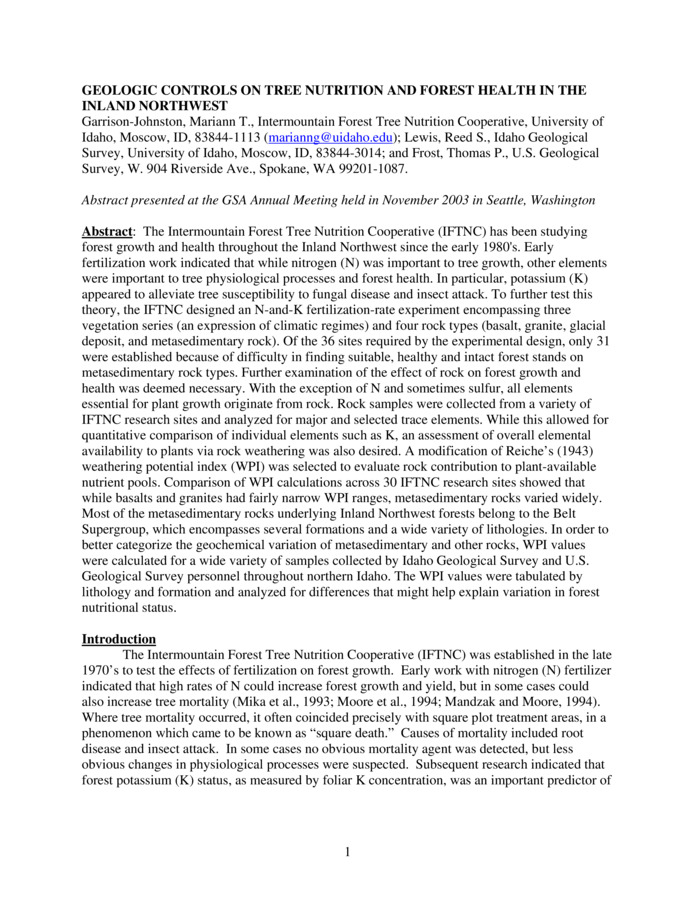PDF
Geologic Controls on Tree Nutrition and Forest Health in the Inland Northwest Item Info
- Title:
- Geologic Controls on Tree Nutrition and Forest Health in the Inland Northwest
- Creator:
- Garrison-Johnston, M.T.; Lewis, R.S.; Frost, T.P.
- Date Created (ISO Standard):
- 2003-11-01
- Description:
- The Intermountain Forest Tree Nutrition Cooperative (IFTNC) has been studying forest growth and health throughout the Inland Northwest since the early 1980's. Early fertilization work indicated that while nitrogen (N) was important to tree growth, other elements were important to tree physiological processes and forest health. In particular, potassium (K) appeared to alleviate tree susceptibility to fungal disease and insect attack. To further test this theory, the IFTNC designed an N-and-K fertilization-rate experiment encompassing three vegetation series (an expression of climatic regimes) and four rock types (basalt, granite, glacial deposit, and metasedimentary rock). Of the 36 sites required by the experimental design, only 31 were established because of difficulty in finding suitable, healthy and intact forest stands on metasedimentary rock types. Further examination of the effect of rock on forest growth and health was deemed necessary. With the exception of N and sometimes sulfur, all elements essential for plant growth originate from rock. Rock samples were collected from a variety of IFTNC research sites and analyzed for major and selected trace elements. While this allowed for quantitative comparison of individual elements such as K, an assessment of overall elemental availability to plants via rock weathering was also desired. A modification of Reiche's (1943) weathering potential index (WPI) was selected to evaluate rock contribution to plant-available nutrient pools. Comparison of WPI calculations across 30 IFTNC research sites showed that while basalts and granites had fairly narrow WPI ranges, metasedimentary rocks varied widely. Most of the metasedimentary rocks underlying Inland Northwest forests belong to the Belt Supergroup, which encompasses several formations and a wide variety of lithologies. In order to better categorize the geochemical variation of metasedimentary and other rocks, WPI values were calculated for a wide variety of samples collected by Idaho Geological Survey and U.S. Geological Survey personnel throughout northern Idaho. The WPI values were tabulated by lithology and formation and analyzed for differences that might help explain variation in forest nutritional status.
- Subjects:
- research fertilizer timber (lumber) statistics
- Source:
- Garrison-Johnston, M.T., R.S. Lewis and T.P. Frost, 2003. Geologic controls on tree nutrition and forest health in the inland northwest. Proceedings of the 2003 Geological Society of America Convention, November, Seattle, WA, published by the Geological Society of America. (Poster Presentation.)
- Source Identifier:
- Geologic_Controls_on_Tree_Nutrition_and_Forest_Health_in_the_Inland_NW_IFTNC_2003
- Type:
- Text
- Format:
- application/pdf
Source
- Preferred Citation:
- "Geologic Controls on Tree Nutrition and Forest Health in the Inland Northwest", Intermountain Forestry Cooperative, University of Idaho Library Digital Collections, https://www.lib.uidaho.edu/digital/iftnc/items/iftnc4840.html
Rights
- Rights:
- This document is provided by the University of Idaho Library for use by University of Idaho students, staff, and faculty. All rights to the document linked from this metadata belong to the author, rights holder, and/or provider. For more information contact The Intermountain Forestry Cooperative, https://www.uidaho.edu/cnr/ifc
- Standardized Rights:
- http://rightsstatements.org/vocab/InC-EDU/1.0/

